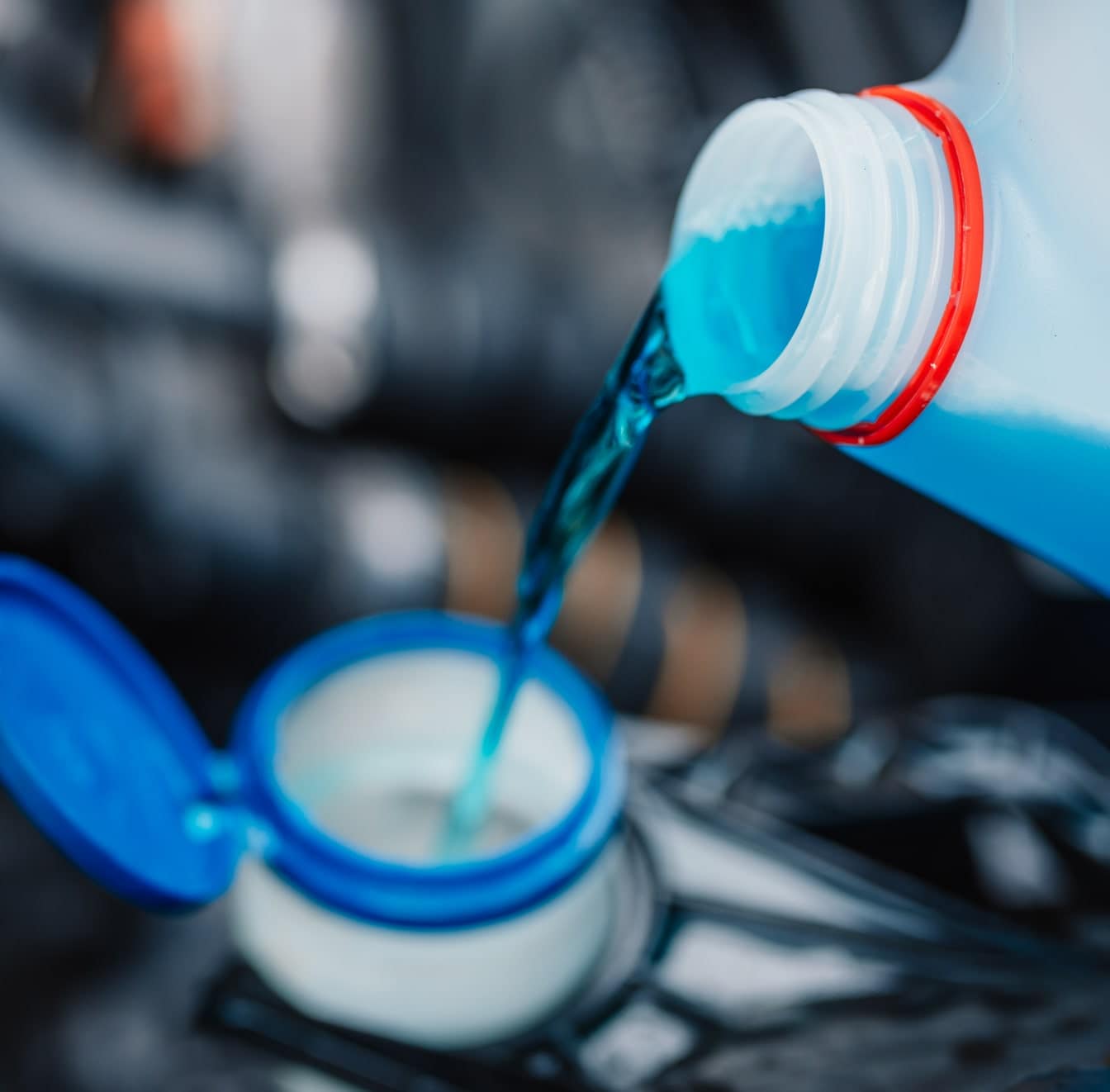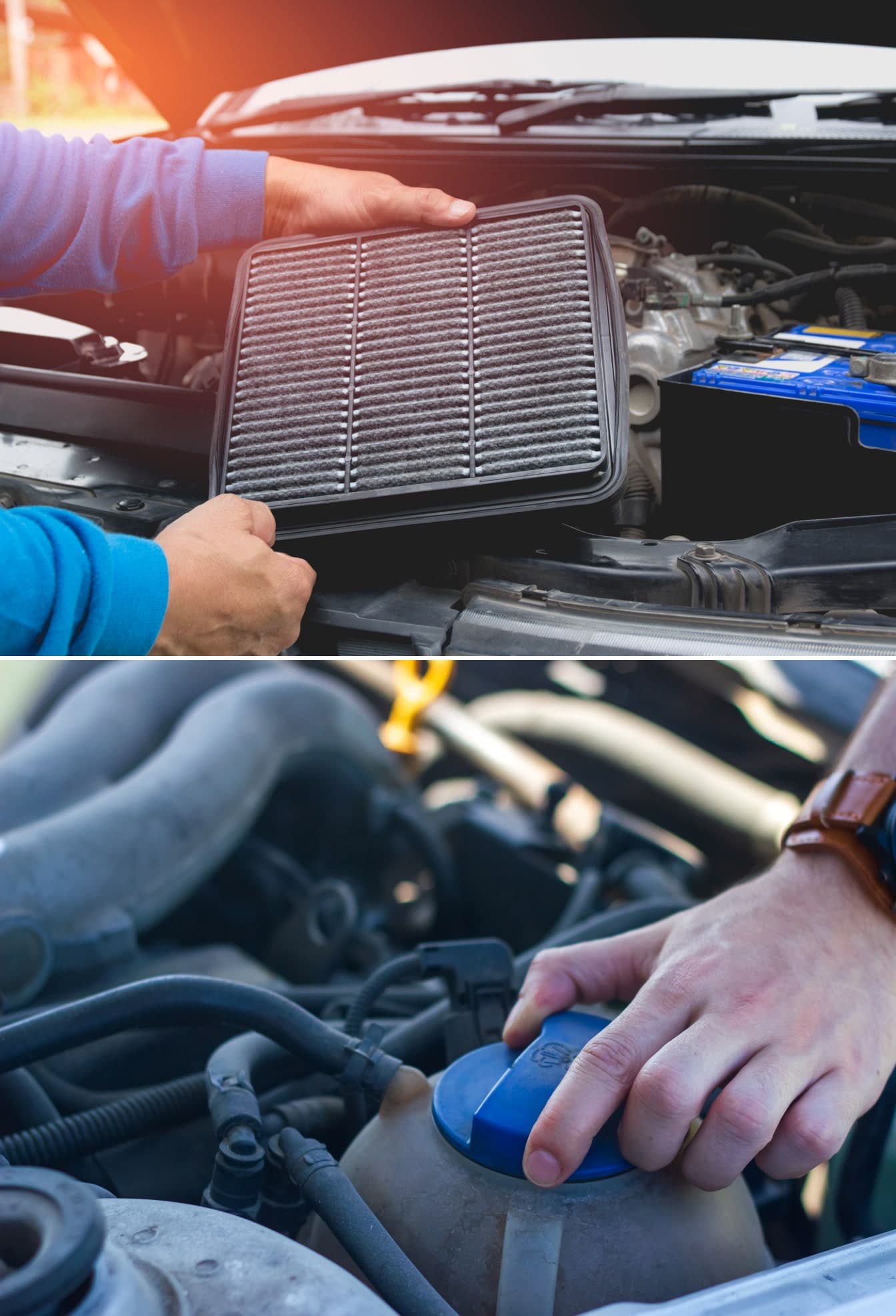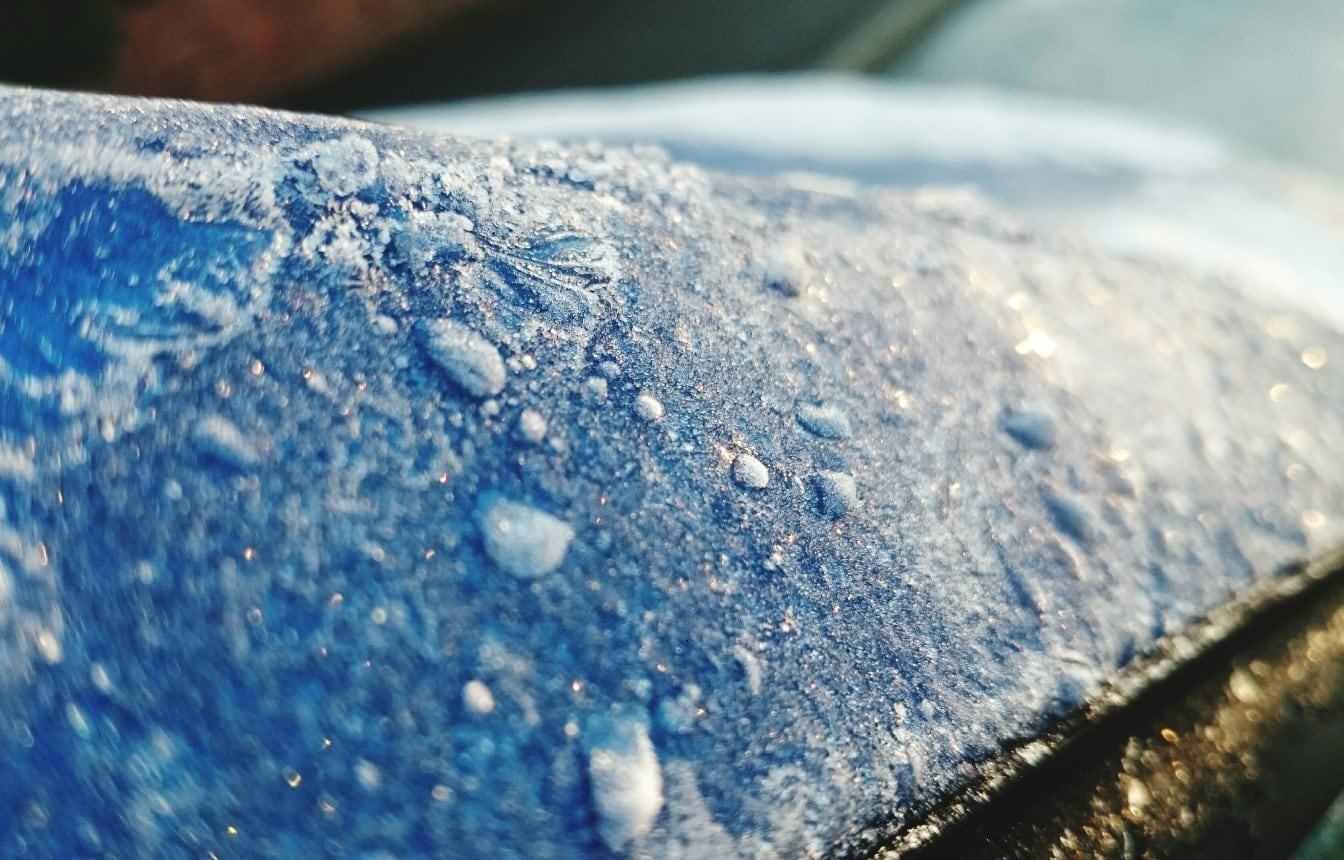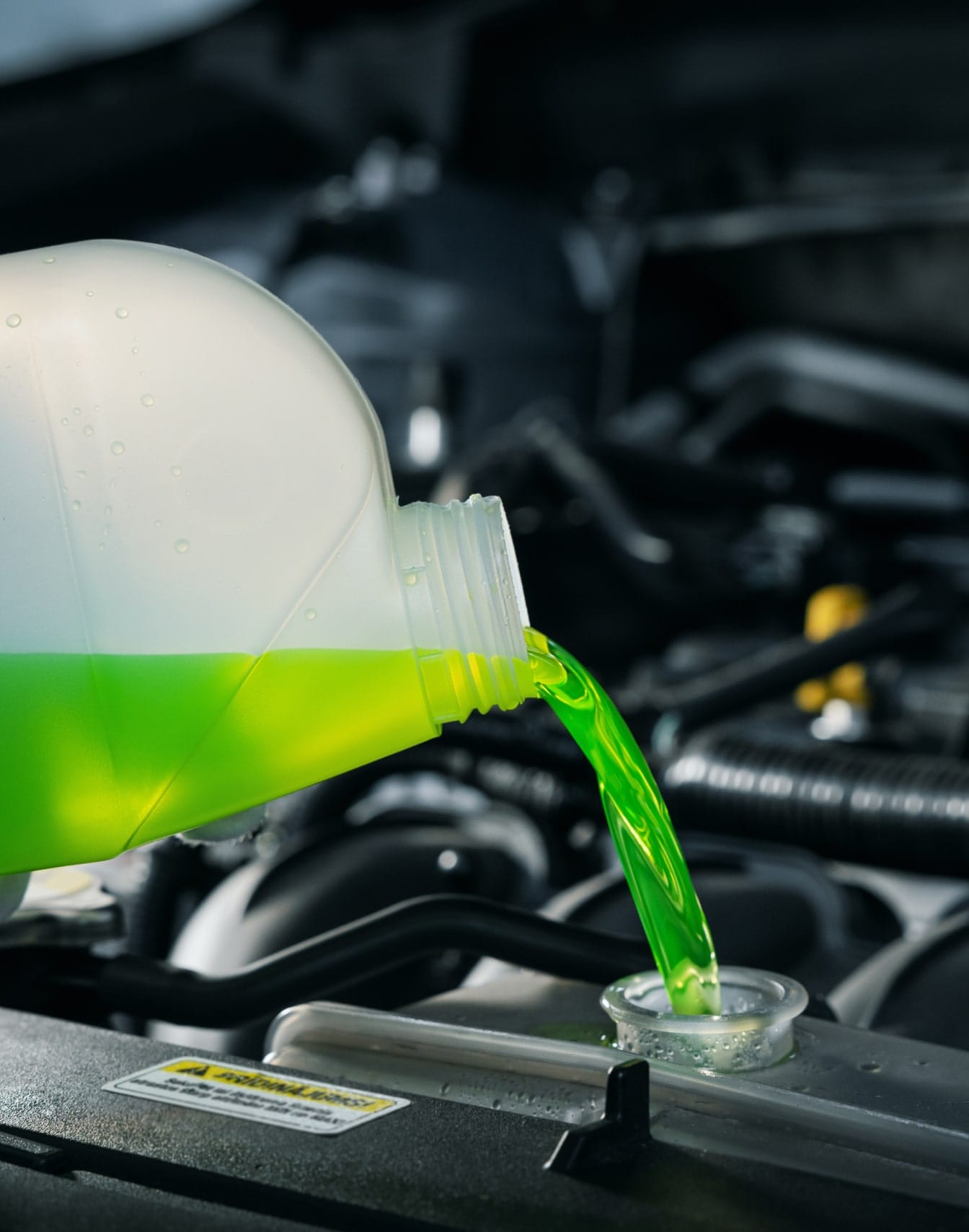Car Coolant And Antifreeze: Types, Maintenance, And Troubleshooting

Car coolant and antifreeze keep your vehicle's engine cool and prevent issues with frozen hoses in the winter. That's a simple enough concept, but as with any other automotive system, there are a lot of nuances and intricacies to consider. Whether you're searching for the difference between coolant and antifreeze types or the signs of coolant issues, you can get a thorough look into the world of car coolant and antifreeze with our guide below.
Car Coolant vs. Antifreeze
Coolant is usually just water. Antifreeze is a glycol-based fluid that gets added to the coolant to prevent the water from freezing in the cold, as its name suggests.
More importantly, antifreeze helps the coolant clean the engine and regulate overall temperature more effectively. It's also the component that gives car coolant its distinct neon-ish appearance. Antifreeze is usually a bright neon green, but it can also be teal-blue or orange. Oddly enough, it smells like maple syrup when it burns.
A typical car coolant and antifreeze mixture is a 50/50 blend. Keep in mind that these fluids are almost always found together, and almost all modern car coolants already have antifreeze in them – so, you can refer to "antifreeze" as "car coolant" and vice versa.
What Does Antifreeze Do?
To recap, antifreeze is a glycol-based additive that is mixed in with a water-based coolant. It does the important job of preventing the water-based coolant from freezing in the winter and also helps it better regulate temperatures while your car's engine is operating. Most modern car coolants are a 50/50 mix of water and antifreeze.

What Does Coolant Do in a Car?
Now that you know the basics of car coolant and antifreeze, let's look at these fluids in action.
Coolant is pumped out from a reservoir in your car's radiator, circulates through a maze of hoses, and flows into special channels in the engine, pulling heat out of the engine and transmitting it into the radiator. The radiator and a special fan then cool down the hot coolant fluid and send it back into the engine to repeat the process continuously as you drive.
This flow of fluid helps keep engine temperatures stable for reliable performance. Consider the fact that there's a constant fire raging in the engine – without this fluid circulation, that fire would create more and more heat until the surrounding components literally melted down. That's what's known as an overheating engine, and car coolant and antifreeze are designed to prevent it from happening.

What Is a Coolant System?
The coolant system is the full set of parts that store, pump, guide, and make use of the coolant. Here's a quick look at the essential parts:
- Radiator: the main coolant tank and a complex heat exchanger that cools down the coolant fluid via airflow
- Thermostat: a small thermometer that measures coolant temperature and uses it to determine proper coolant flow
- Cooling fan: a fan that assists the radiator in cooling down the coolant
- Water pump: a critical component driven by the engine that pumps the car coolant and antifreeze through the coolant system
- Coolant expansion tank (AKA coolant reservoir): fluid expands as it heats up – this small reservoir contains the excess coolant fluid when that happens
- Coolant hoses: thick rubber hoses that the coolant flows through; several varieties exist
- Coolant channels/jackets: cut-out flow channels and layers inside the engine block – the coolant absorbs the engine's heat as it flows through these areas
While this all can seem complicated, the answer to "What is coolant?" is very simple overall: It's a cooling fluid that flows through the engine and absorbs heat.
As an added fun fact, when you use your car's climate control system to heat your cabin, the heat that comes out of the vents actually comes from the coolant. A heater core receives the flowing coolant and transfers its heat to a blower and then through the vents to warm your car's interior.
What Are the Benefits of Car Coolant and Antifreeze?
Coolant, as discussed, keeps the engine's heat in check and allows it to run without overheating. As coolant flows through the engine itself, it also helps maintain the metal inside of the engine.
Car coolant and antifreeze often have special anticorrosion additives to help prevent the engine's internals from rusting and strip away any rust that forms. The same is true when car coolant flows through the radiator.
Since a radiator is a large fluid tank with hundreds of metal fins, rust can form easily. Fresh coolant will also help keep the radiator clean – a dirty and rusted radiator is much less effective at cooling down the coolant fluid.

What Happens if the Engine Overheats?
Now that we've talked about how car coolant and antifreeze prevent the engine from overheating, you're probably wondering what exactly happens when that situation occurs. Here's a quick look at the damage an overheating engine can cause:
- Burnt engine oil: The moving engine parts rely on oil to operate, and if the engine overheats and burns the oil, those many parts will be damaged by the sudden increase of friction.
- Warped metal components: The parts mentioned above are engineered to operate in a specific temperature range. An overheating engine will exceed that range and can warp and destroy the metal of those parts.
- Seized engine: With warped metal parts or general overheat damage to seals (like piston rings), an engine will very likely "seize up" and stop working entirely.
To sum all of that up, an overheated engine is a damaged engine. Serious repairs will likely be necessary, so it's always worth the money to keep your coolant system performing at its best and avoid more expensive overheated engine repairs.

What Happens if the Coolant Freezes?
Antifreeze is necessary for all cars that drive in winter temperatures because it prevents the coolant from freezing. Frozen coolant will expand, which can crack the coolant hoses, over-stress the metal inner workings of the engine, and generally cause harm wherever coolant flows through. Additionally, frozen coolant can cause blockages in the hoses and pipes, which will lead to many other issues if you start the car.
Car Coolant and Antifreeze Maintenance 101
Like most fluids, car coolant and antifreeze are simple to maintain – they just need to be replaced whenever they go bad. However, the components they flow through have more complicated maintenance requirements, and neglecting them can lead to trouble. Here's an overview of how to maintain and service coolant and your car's coolant system.
How to Check Coolant Level?
Unlike an oil level check, checking car coolant and antifreeze levels is very simple. Your car's coolant reservoir will have a scale on the side of it with an "L" ("Low") and an "F" ("Full"), which will let you see your car's coolant level at a glance.
How Do I Know if My Car Needs Coolant?
If the coolant level approaches the reservoir's "L" marker, your car needs more coolant. There are several symptoms you may notice when your car runs with low coolant. Most notably, the engine temperature gauge will creep up higher than usual. A dashboard warning light may also illuminate to warn you of a low coolant level; it looks like a red thermometer.
When Does Coolant Need To Be Changed?
Generally speaking, a modern Volvo vehicle should receive a coolant change every two to five years, or around 30,000 to 60,000 miles. This is an approximate maintenance estimate – your owner's manual will provide more specific guidelines on when to change the coolant. Car coolant and antifreeze, like other vehicle fluids, can be compromised naturally over time and mileage.
Changing your car's coolant according to the official maintenance schedule will ensure that this vital fluid can do its job as effectively as possible.
Why Do Car Coolant and Antifreeze Need To Be Changed?
Expanding on the last section, coolant fluid will need to be changed (or "flushed") for several reasons. It can be compromised by metal particles, and the antifreeze chemicals can degrade under intense engine heat. Coolant will also perform its engine-cooling job less effectively as it ages.
How Do I Choose the Right Car Coolant and Antifreeze for My Car?
For drivers of new and old Volvo vehicles, our service center in Raleigh, NC, can pick the right coolant and antifreeze for your car, and our selection of Volvo service coupons and discounts may include a deal on it. Your owner's manual likely has a specific coolant/antifreeze recommendation for your car, too.
How Do I Add Car Coolant and Antifreeze?
If your car's coolant level was at the "L" in the reservoir, and you do not see any leaks, notice your engine overheating, or smell the maple syrup scent, you can add coolant and will generally be good to go.
As a word of warning, never add coolant right after driving the car. Wait several hours for the coolant to cool down, since it will be dangerously hot after the engine has been active.
To add coolant, you can usually open the coolant reservoir cap, insert a funnel, and pour in the car coolant and antifreeze until the fluid level is between the "L" and "F" marks in the reservoir. Sometimes, however, you may need to open the radiator to add coolant. If so, contact our service center for help.

How Do I Know if My Coolant System Needs To Be Serviced or Repaired?
Much like oil change service, the car coolant and antifreeze should be drained and replaced at specific intervals. The other parts of your coolant system (like the hoses) should be frequently inspected for issues, too. Some urgent signs of coolant system problems include:
- Visible leaks of green/blue/orange fluid beneath your car: This means the hoses, radiator, and seals may be damaged, and coolant levels can become dangerously low.
- Cabin heater doesn't work: The coolant level is dangerously low, and the fluid is not reaching the heater core. The engine may soon overheat.
- Sweet maple syrup smell coming from the engine bay: Coolant is burning. Either it's leaking from the hoses and onto the hot exhaust pipes, or a seal has broken, letting coolant enter the engine cylinders, which is especially dangerous.
- Rusty coolant in the reservoir: The coolant has been compromised. The inside of the engine may be rusting.
- Dashboard warning light (a red thermometer symbol): The computerized systems have detected a low coolant level.
- High engine temperature gauge: The engine is overheating. Pull over as soon as possible and call roadside assistance.
If any of these symptoms arise, schedule your next service appointment ASAP to avoid further damage to your car.
Frequently Asked Questions
What makes car coolant and antifreeze important?
An engine is a block of metal filled with chambers of fire. Fire, naturally, is a major source of heat, and if that heat is left unchecked, things can literally melt down. Car coolant and antifreeze flow through special channels in the engine and absorb a large amount of heat. The fluid then goes into the radiator, the heat dissipates, and the process repeats to prevent the engine from overheating.
How often should I check my car's coolant?
You should generally check your car's coolant twice per year or whenever seasonal temperature changes occur. Car coolant and antifreeze are relatively stable fluids, but because they serve a critical role in engine performance and reliability, it's best to check them whenever you can. If the coolant smells like maple syrup, looks murky, or is any color except for bright green, blue, or orange, it needs to be changed.
What are the signs of coolant problems?
If your engine temperature gauge sits higher than normal, even by a smidge, there may be coolant problems in your car. Other signs include a sweet maple-syrup-like smell coming from your car, bright green/orange/blue fluid leaking from the car, lower-than-normal performance and fuel efficiency, and low coolant reservoir levels. Ignoring coolant issues can lead to catastrophic engine damage.
Contact Us Today
* Indicates a required field